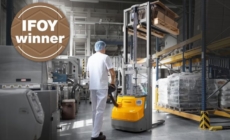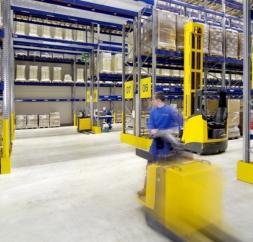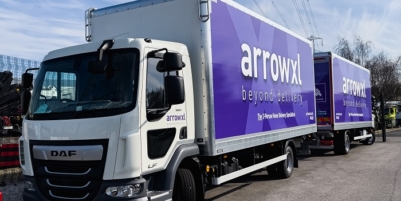-
ROSSLARE EUROPORT TARGETS HEALTH & SAFETY WITH CAMERA TELEMATICS PARTNERSHIP - 2 days ago
-
Landmark Study Reveals Wearable Robotics Significantly Boost Safety and Efficiency in Industrial Environments - July 24, 2024
-
Visku Tackle The Retail Seasonality Challenge One Pallet At A Time - July 22, 2024
-
KAMMAC AND BERGEN LOGISTICS STRENGTHEN FASHION & LIFESTYLE SERVICES IN THE UK - July 19, 2024
-
TENTBOX EXTENDS PARTNERSHIP WITH ARROWXL TO SUPPORT INCREASING DEMAND - July 17, 2024
-
The Perfume Shop improves customer journeys while driving profitability in partnership with Scurri - July 17, 2024
-
ZEROMISSION SECURES £2.3M ($3M) INVESTMENT TO ACCELERATE ELECTRIC FLEETS - July 16, 2024
-
BCMPA CELEBRATES SUCCESS OF 2024 CONFERENCE - July 15, 2024
-
Best of the Best: Jungheinrich Celebrates Triple International Award Win - July 12, 2024
-
GOPLASTICPALLETS.COM CALLS ON NEW CHANCELLOR RACHEL REEVES TO CONSIDER PLASTIC PACKAGING TAX REFORM - July 10, 2024
Edward Hutchison, Managing Director of BITO Storage Systems, looks at how companies can create high density storage to meet the challenges of warehouse space and labour availability.
Companies are often challenged to hold greater volumes of stock on diminishing footprints. In the case of retailers this may be to support multiple channels. This need is exacerbated by low availability of good quality warehouse space, and what is available is becoming more costly. In addition to overcoming these issues, having more stock on a smaller footprint means SKU lines can be stored closer together to reduce order picking times to provide faster fulfilment. In factories and assembly plants, space is generally prioritised for manufacturing processes, but sufficient stock will generally be needed in close proximity to production lines to ensure they keep flowing. These are just some of the reasons why companies may want high density storage, but what are the ways to achieve it?
Determining how dense your storage needs to be will depend on several factors. These include stock profile, investment costs of the racking installation; handling/transport costs per item, which includes the cost of internal transportation and labour; handling capacity measured in picks, ie, the quantity of items retrieved per unit of time; optimum utilisation of the available headroom and footprint of a warehouse or storage area.
If you do not need to retrieve goods in a specific sequence then drive-in racking is an option for efficiently and safely storing and retrieving huge stock volumes. This is particularly relevant for large volumes of the same line item, pressure-sensitive goods and unstable pallet loads, where Last In, First Out (LIFO) will do.
An alternative option for optimising space is to install mobile pallet racking or mobile cantilever racking, where the rack moves to open up a single aisle at the required location. It can improve storage capacity by up to 200 per cent on the same footprint or reduce floor space occupation by 50 per cent, however pickers must wait for the racks to move and the aisle to open up. This makes it more relevant for items that are not picked frequently.
In warehouses where picking is more regular activity, then Pallet and Carton Live Systems create concentrated storage and pick faces within a given footprint, allowing easier installation into an existing building. Live systems will give ample storage and pick face density without the need for exact floor tolerances, which may be the case for an automated storage and retrieval system. Adding pick-to-light and pick-to-voice technology to live storage can further improve accuracy and pick rates.
With live storage, each product line can be presented in a separate flow lane and is directly accessible at the pick face. Cartons or pallets are fed into the flow lane from an aisle at the rear. Each item gently moves on rollers to its pick position at the front. Sufficient replenishment quantities guarantee constant product availability. In addition to providing compact storage on a small footprint, live systems work on the FIFO (First In First Out) principle, which allows easy control of production batches and sell-by dates. Separate loading and picking aisles increase operator performance and can improve safety as separating replenishment stock carried by lift trucks and pedestrian order picking in different aisles.
For many applications, this kind of ‘mechanical’ solution strikes the right balance between investment, density and speed for fast moving goods picked on a FIFO basis. Adding simple automation technologies such as pick-to-light and voice picking will further improve accuracy and throughput speed.
A high-rise narrow aisle structure will make good use of vertical capacity and efficient use of floor space. As a rule, narrow aisle facilities are serviced with man-operated stacker cranes or order picking trucks. This allows picking of smaller unit loads from all racking levels. Guide rails and inductive steering ensure that service vehicles always keep the ideal distance to the installation. Using VNA (Very Narrow Aisle) trucks, will allow aisle widths typically between 1.6 and 2 metres, and the trucks generally operate up to approximately 15 metres high. Going higher means broader trucks and therefore wider aisles. High bay automated warehouses served by stacker cranes can theoretically attain heights in excess of 40 metres, though just over 30 metres is more common. These generally create the highest density solutions.
A combination of factors has made it harder for the logistics sector to rely on manual labour, which it has traditionally leaned heavily on. This has changed the cost balance for automated storage. Constantly improving in terms of modularity, sophisticated control systems, and performance developments, automation is increasingly becoming a more practical and flexible solution for a greater variety of ‘goods to picker’ installations.
No matter what the application, to gain the greatest advantage from automated storage and retrieval systems, requires paying attention to the design of the racking. This requires sourcing racking from a supplier, such as BITO, which can provide uprights in a range of widths to allow optimum adaptation to different load requirements and building constraints to achieve the density of storage required. Indeed, such a supplier will be able to advice and design the appropriate high density storage solution to meet any challenge.

































